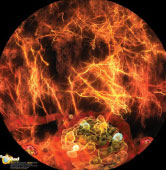Contents
Research Briefs
A Planetarium Show on Diabetes
“Not all children who play baseball become professional ball players, but they do learn to appreciate the sport,” says John A. Pollock, biology professor at Duquesne University in Pittsburgh, Pa. Through innovative methods, including movies, video and board games, and Internet sites, Pollock has been finding ways to get children and their families to appreciate not baseball but science. “We don’t intend all children to become scientists; rather, we hope to foster an appreciation and understanding of science and its influence on their lives.”

The planetarium show “Our Cells, Our Selves” takes viewers on a journey to explore the immune system and understand diabetes—a disease that starts in islet cells (shown in the photo) in the pancreas. Photo courtesy of Regenerative Medicine Partnership in Education.
His latest endeavor is the world’s first high-definition video planetarium show on biomedicine, which opened at the Henry Buhl, Jr. Planetarium and Observatory at the Carnegie Science Center in Pittsburgh last November. Sponsored by the Regenerative Medicine Partnership in Education, a program supported through an NCRR Science Education Partnership Award (SEPA) to Duquesne University, the show “Our Cells, Our Selves” explores type 1 diabetes, an autoimmune disease that results in the permanent destruction of the insulin-producing islet cells of the pancreas.
The movie is presented as a bedtime story told to 7-year-old Sylvie, recently diagnosed with diabetes. Through colorful and engaging animations, the story explains how the immune system works, what goes wrong in diabetes, and how stem cells may provide a cure.
Reactions to the 16-minute show have been overwhelmingly positive. “Even very young children remain attentive,” says Pollock. He has been particularly gratified by comments from children diagnosed with diabetes who appreciated being able to “see” the disease and asked him when stem cell therapies would be available.
Pollock hopes to distribute “Our Cells, Our Selves” to other museums this spring. He also is considering developing a DVD version of the movie that could be distributed to rural communities that may not have access to a museum.
The show builds on an earlier project, the Tissue Engineering Show and Education Partnership, also funded by a SEPA grant. Similar to that project, “Our Cells, Our Selves” includes a movie and accompanying educational resources, such as classroom workbooks as well as online and outdoor activities.
Pollock credits many individuals who contributed to the success of the current project, including Creative Director Laura Lynn Gonzalez, who worked with Pollock to develop the topic and approach to the show. Students from both Duquesne and Carnegie Mellon universities contributed to the digital animation.
–Amber Boehm
NCRR Resources: NCRR’s Science Education Partnership Awards are designed to improve life science literacy throughout the nation. Educators can receive free copies of the movies and workbooks developed by the Regenerative Medicine Partnership in Education.



